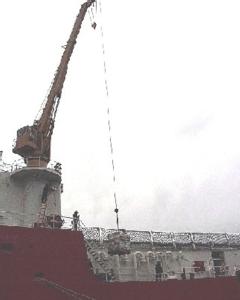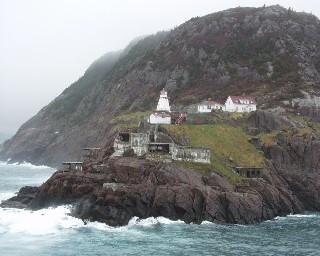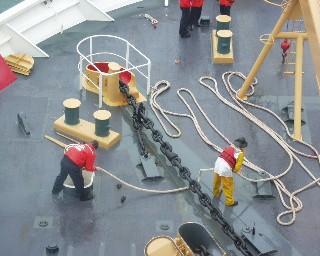26 May, 2000
And weíre off!
Today was departure day for the Healy, and everyone was busy preparing to
leave. Before the ship departs, it is important that they have all the food,
supplies, fuel, and equipment that they may need while at sea. Great care
goes into planning so that once the ship is at sea, it will be able to run
smoothly and safely. Giant cranes helped to load the many, many boxes of
food, supplies, and equipment.
The ship takes a full day to refuel as it has four 12-cylinder diesel
engines and can hold 1,200,000 gallons of fuel! My little Honda Accord
holds about 20 gallons. If I filled my gas tank once a week, how many weeks
do you think it would take for me to use as much fuel as the Healy holds? Of
course, I wonít be breaking through any ice floes!
About 11:00 a.m. we raised the gangplank, unfastened the mooring lines, and
set sail from St. Johnís. You can see the men on the bow in the picture
below putting the mooring rope down through deck hatch to a hold below this
deck.
When leaving the dock, a local pilot must escort large ships like the Healy
out of the harbor. A pilot is a person who is very familiar with this
parcticular harbor and able to assist in being sure that the ship safely
leaves through these shallow waters. Once the Healy was out about a mile or
so and the pilot felt that the waters were safe, the pilotís boat drove up
along side the Healy. The pilot turned the control of the ship back to
Captain Garrett and climbed down a rope ladder from the Healy onto his own
boat to return to home.
As we left the shores of St. Johnís, we saw beautiful sites with rocky
hills, homes and a lighthouse. We watched as the land faded from view and
ocean was all that we could see.
At dinner that night I spoke with a man named Bob who had been on the bridge
of the ship for the first few hours we were out to sea. Bob was lucky enough
to see a humpback whale swimming along side the ship. What a treat! Maybe if
I keep my eyes to the sea, Iíll spot something tomorrow, but today we mostly
saw fog!
When dressing for a day in the Arctic we will be wearing loose boots, socks,
and clothing to make it easy for our blood to circulate and therefore keep
us warmer. Dressing in layers of clothing also keeps you warmer, and makes
it easy to remove a layer if you get too warm. If you needed to be rescued,
youíd be more easily spotted in brightly colored clothes! (adapted from the
book POLAR REGIONS by Lorraine Hopping Egan)
To learn more about preparations for being safe in the Arctic, read Janiceís
page:
<../tea_rosenbergfrontpage.html>
You can also find the answer to the question: Which direction have we
traveled since yesterday?
DAILY DATA LOG (5/26/00):
air temperature: 3 degrees C / 37 degrees F
latitude 48N
longitude 48W
sunrise 4:15 a.m.
sunset 7:56 p.m.

This is a picture of the huge crane that helps to load supplies and equipment onto the Healy.

The pilot has returned to his boat and is heading back to St. John's. Thanks for the help! We're off to sea now.

This lighthouse is called Fort Amherst. We passed by it on our way out of St. John's. Isn't it a beautiful spot?

This is the bow of the ship. Can you see where they are feeding the mooring line into the hatch on the deck. It will be stored and dry below the deck.
Contact the TEA in the field at
.
If you cannot connect through your browser, copy the
TEA's e-mail address in the "To:" line of
your favorite e-mail package.
|
